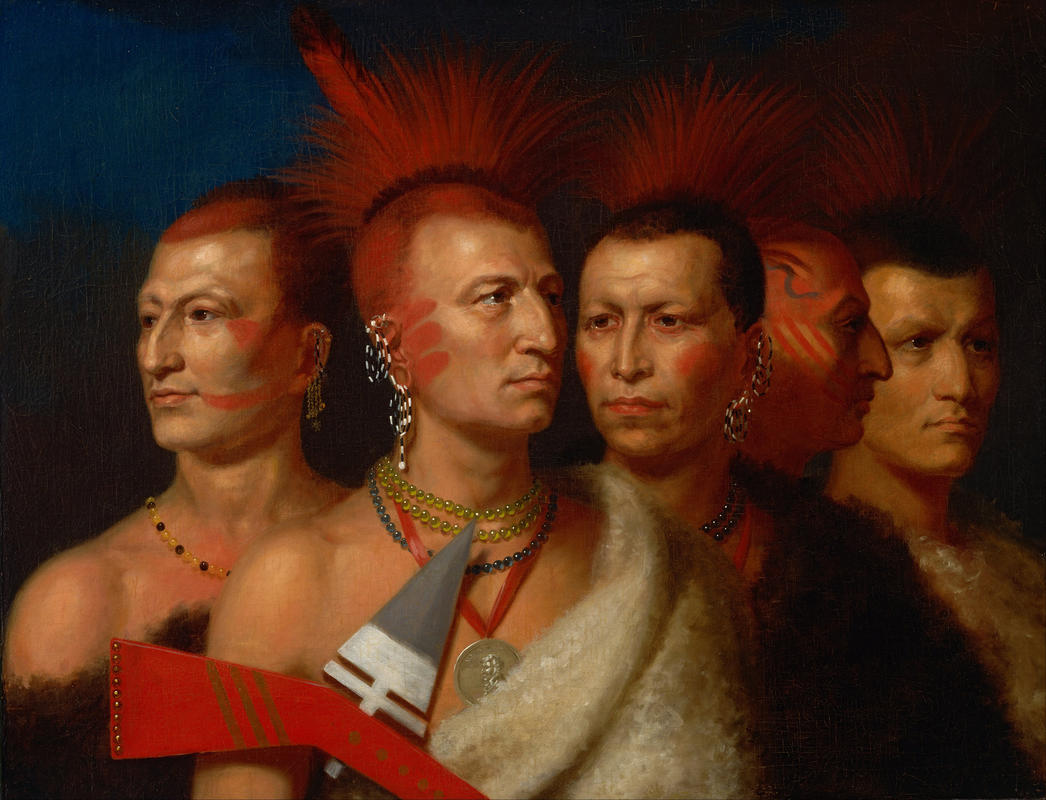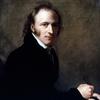More about Young Omahaw, War Eagle, Little Missouri, and Pawnees

Contributor
Despite the resemblance to an album cover, the men in Young Omahaw, War Eagle, Little Missouri, and Pawnees are political leaders, not band members.
Charles Bird King's composition is a document marking the state-to-state relationships between various Midwestern indigenous nations and the government in Washington. Then as now, the primary function for many participants in "Indian policy" government in Washington was to make this "Indian problem" just go away, speedily, miraculously, and quietly. The idea of the settlers receiving divine title by Providence to all the land from "sea to shining sea" was inconveniently undercut by the fact that so many people were already here (and, as Maya Lin reminds us, have been building great artworks for many centuries). This, apparently, was not a sufficient reason to quench the settler's thirst for new real estate speculations.
This is not like a group portrait of European leaders, even if it may formally resemble one, because, as far as I can tell, only one of these men, War Eagle, has a proper individual name linking the face with a specific historical figure. The strange pseudo- or total anonymity of the other four men is not so strange in light of the "Indian policy" of the government at the time, and our country's general track record of understanding and respecting indigenous culture. At the left side, according to the title, a man wearing warpaint represents the Umoⁿhoⁿ people. The little superscript n's in the Umoⁿhoⁿ name, which means "upstream," indicate that the n is a nasal sound, like you hear in French, and can make the name sound like "Omaha," which is how the largest city of Nebraska got its name.
War Eagle, or Waŋbdí Okíčhize in Dakota, eventually adopted by the Yankton people, was probably born around 1785 to the Isáŋyathi or Santee, "people who live at the place of knife flint." The Yankton call themselves Wičhíyena (″Those Who Speak Like Men″), and they produced the great poet and political leader Zitkála-Šá, Red Cardinal in Lakota. She produced the opera, the Sun Dance Opera, in 1913, and American Indian Stories in 1921.
You might as well assume that "Little Missouri" receives his moniker from King (by a naming convention popular with the likes of Lil' Kim) to give a name to a man of the Missouri or Niúachi, who were evicted from their lands by the government because crude oil was under their feet.
The matrilineal Pawnee have produced the great oil painter Acee Blue Eagle and the Echo-Hawk family, whose members include John, the founder of the Native American Rights Fund, legal scholar Walter Echo-Hawk and the artist Bunky Echo-Hawk, whose singular masterpieces include portraits of Yoda in full regalia.
The painter John Gadsby Chapman owned Young Omahaw, War Eagle, Little Missouri, and Pawnees in 1838. A label on the back of the stretcher once read: "Young Omahaw, War Eagle, Little Missouri, and Pawnees. Painted at Washington City, 1821, by C.R. [sic] King." Because this work may have been a studio study, it did not burn with King's other works when the Smithsonian caught fire in 1865.
Sources
- Alberts, Crystal. "Whereas by Layli Long Soldier." Studies in American Indian Literatures 30, no. 1 (2018): 117-121.
- Chamberlain, Georgia Stamm. Studies on John Gadsby Chapman: American artist, 1808-1889. Annandale, MD: Turnpike, 1963.
- Hafen, P. Jane. Dreams and Thunder: Stories, Poems, and the Sun Dance Opera. Lincoln, NE: University of Nebraska Press, 2005.
- McLaughlin, Olena. "Native Pop: Bunky Echo-Hawk and Steven Paul Judd Subvert Star Wars." Transmotion 3, no. 2 (2017): 30-52.
- US Senate Hearing on the District of Columbia, Second Session, Jun. 22, 1972. Washington: US Government Printing Office, 1972.
- Vogel, Virgil J. Indian Names on Wisconsin's Map. Madison, WI: University of Wisconsin Press, 1991.
- William, Kloss. Treasures of NMAA. Washington: Smithsonian, 1986.
Featured Content
Here is what Wikipedia says about Young Omahaw, War Eagle, Little Missouri, and Pawnees
Young Omahaw, War Eagle, Little Missouri, and Pawnees is an 1821 painting by the American portrait artist Charles Bird King (1785–1862), who is best known for his portrayals of significant Native American leaders and tribesmen.
The painting portrays Plains Indian chiefs, who among many others traveled to Washington to meet with the president to negotiate Native American territorial rights with the government. At the White House, the Capitol, and in private homes, policymakers employed bribery, dazzle, and intimidation to win the cooperation of these men. In his Seventh Street studio, Charles Bird King painted their portraits, creating a gallery of allies in the government's plan to settle the Indian question peacefully.
Young Omahaw, War Eagle, Little Missouri, and Pawnees portrays Chief War Eagle with a presidential peace medal, valued by Native Americans as a sign of status and worn on all formal occasions. King painted the chiefs with a war axe, blood-red face paint, and eagle feathers atop their heads, reinforcing the romantic image of Indians as savages.
Check out the full Wikipedia article about Young Omahaw, War Eagle, Little Missouri, and Pawnees












